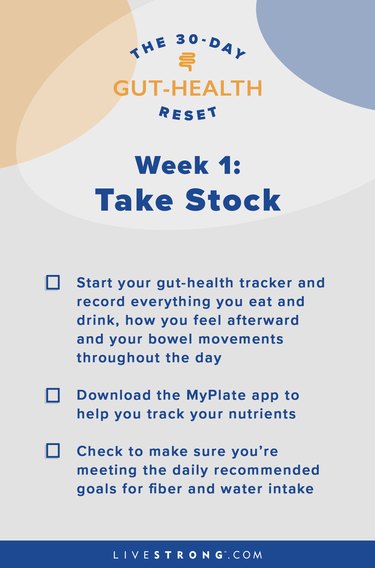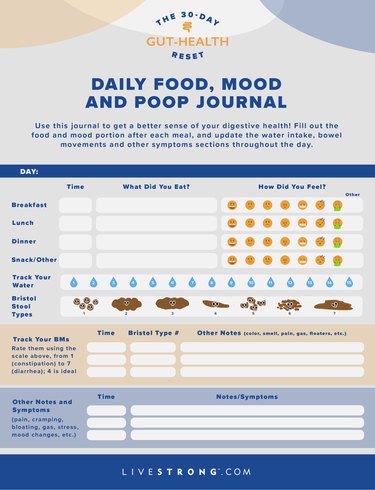
The gut is a hard thing to ignore when it's not working the way it should. Diarrhea, constipation, bloating, gas — each unpleasant symptom is quite effective at forcing you to pay attention to your digestive health.
"But you don't have to have gut symptoms to have a gut-related health issue," says Vincent Pedre, MD, author of Happy Gut and creator of the 28-Day Happy Gut Cleanse and Happy Gut app.
For instance, gut imbalances and conditions like irritable bowel syndrome and celiac disease have been linked to chronic fatigue syndrome, migraine headaches and a variety of skin conditions (such as acne, psoriasis and rosacea), according to according to an April 2017 study in Microbiome, a February 2020 review in the Journal of Headache and Pain and a November 2019 article in Microorganisms, respectively.
Your gut affects much more than the amount of time you spend in the bathroom, which is why it's important to pay attention to your digestive health even when you're not experiencing symptoms.
Addressing both the obvious and not-so-obvious symptoms is one of the benefits of our 30-Day Gut-Health Reset with Dr. Pedre. For this first week, you'll lay the foundation by taking stock of your digestive health. You'll track what you're eating and drinking as well as your bowel movements so you can identify trends and make small, simple changes that help you feel better.
Your Goals for Week 1
- Start your gut-health tracker
- Calculate your recommended fiber and water intake
New to the challenge? Click here for full details about the 30-day program.
Goal 1: Start Tracking Your Gut Health
Take a second and think through your day from a digestive perspective: Do you remember what you ate? Can you recall how you felt during your meal and in the hours afterward? How much water did you drink?
Keeping track of this information each day in a food journal can be revealing. After jotting down your food and moods for a week, you may realize that you feel particularly sluggish when you start the day off with dairy or that certain highly processed foods leave you feeling bloated.
Use these tips to get the hang of using a food journal:
- Pick a system that works for you: You can opt for pen and paper or download an app — whatever is easiest for you to use consistently.
- Include all the details: You'll want to list what, how much and when you ate, but also where you were, who else was there and how you were feeling as you ate, according to Harvard Health Publishing. Did you have the TV on in the background? Were you scarfing down your kid's leftovers while putting away clean dishes? All these specifics can help you identify patterns later on.
- Be thorough: Don't just track your main meals; note coffee breaks, snacks and anything else you eat or drink. This should be a record of everything you put in your mouth, not just what you ate at breakfast, lunch and dinner.
- Make it a habit: No need to set aside giant blocks of time for this journal. Aim to take notes right after you eat, per the American Academy of Family Physicians — that way you won't forget the details.
Along with tracking what goes in, you'll also want your food journal to function as a digestive symptom tracker and add notes about what comes out. That is, observe and jot down the characteristics of your bowel movements before flushing them, including color, consistency and how frequently you go.
Use the Bristol Stool Chart — which groups poop into seven categories from hard lumps (Type 1) to watery (Type 7) — as your guide to knowing when you are constipated or have diarrhea, per Massachusetts General Hospital.

Your poop's color can be meaningful, too. For instance, green poop could be the result of food moving through your GI tract quickly, per the Mayo Clinic. And while many colors are ordinary when it comes to poop, some are cause for concern, such as black or bright red poop, which can sometimes indicate internal bleeding. (That said, these dramatic colors can also be the result of taking Pepto-Bismol or eating beets, respectively, so they aren't always an issue.)
To make the journaling process easier, we partnered with Dr. Pedre to create a tracker you can download, print out and use throughout the challenge.
Download and print the 30-Day Gut-Health Reset weekly gut-health tracker here. Each page has space for two days. Print as many copies as you'll need.
Goal 2: Check Your Fiber and Water Intake
Most Americans fall far short of their fiber goals, getting just 16 grams a day on average, according to the U.S. National Library of Medicine (NLM). Adults and teens should aim for almost double that amount — between 21 and 38 grams of fiber daily, per the NLM.
There are many good reasons for that recommendation (fiber is important!) but here's one of the best: Eating fiber-rich foods helps digestion. The street sweeper of your GI tract, fiber helps keep things running smoothly and promotes the growth of good gut bacteria.
And drinking plenty of water helps fiber move easily through your digestive system, according to the NLM.
The amount of water you'll need depends on factors like your age and the sex you were assigned at birth, according to the Centers for Disease Control and Prevention. In general, aim for 2.7 liters (about 11 cups) to 3.7 liters (about 15 cups) of total water, according to the National Academies of Sciences.
Before you order yourself a giant water bottle, keep in mind that total also includes the water you get from food. (Hellooo, watermelon!)
Your Takeaways for Week 1
Many symptoms — fatigue, headaches, skin irritation and more — can point to a problem with your gut, Dr. Pedre says. During Week 1 of the 30-Day Gut-Health Reset, you’ll devote attention to your digestive system, getting a sense of lifestyle adjustments that can help your gut flourish by tracking your food, mood, poop, fiber and water.

Click here for a printer-friendly version of this week's plan!
Is this an emergency? If you are experiencing serious medical symptoms, please see the National Library of Medicine’s list of signs you need emergency medical attention or call 911.
